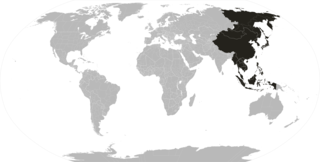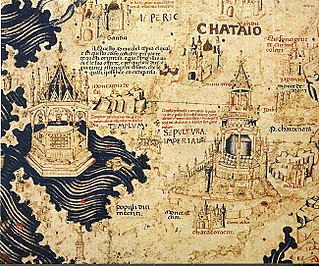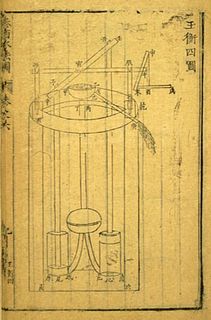
The Far East is a European term to refer to the geographical regions that includes East and Southeast Asia as well as the Russian Far East to a lesser extent. South Asia is sometimes also included for economic and cultural reasons.

Western Europe is the western region of Europe. The region's countries and territories vary depending on context.

The Chinese Rites controversy was a dispute among Roman Catholic missionaries over the religiosity of Confucianism and Chinese rituals during the 17th and 18th centuries. The debate discussed whether Chinese ritual practices of honoring family ancestors and other formal Confucian and Chinese imperial rites qualified as religious rites and were thus incompatible with Catholic belief. The Jesuits argued that these Chinese rites were secular rituals that were compatible with Christianity, within certain limits, and should thus be tolerated. The Dominicans and Franciscans, however, disagreed and reported the issue to Rome.
Sinocentrism refers to the worldview that China is the cultural, political or economic center of the world. It may be considered analogous to Eurocentrism.

Cathay is a historical name for China that was used in Europe. During the early modern period, Europeans thought of Cathay as a completely separate and distinct culture from China. As knowledge of East Asia increased, Cathay came to be seen as the same polity as China. The term "Cathay" became a poetic name for China.
The Xi'an Stele or the Jingjiao Stele, sometimes translated as the "Nestorian Stele," is a Tang Chinese stele erected in 781 that documents 150 years of early Christianity in China. It is a limestone block 279 centimetres high with text in both Chinese and Syriac describing the existence of Christian communities in several cities in northern China. It reveals that the initial Church of the East had met recognition by the Tang Emperor Taizong, due to efforts of the Christian missionary Alopen in 635. According to the Stele, Alopen and his fellow Syriac missionaries came to China from Daqin in the ninth year of Emperor Taizong (635), bringing sacred books and images. The Church of the East monk Adam composed the text on the stele. Buried in 845, probably during religious suppression, the stele was not rediscovered until 1625. It is now in the Stele Forest in Xi'an.
Sinology or Chinese studies, is an academic discipline that focuses on the study of China primarily through Chinese philosophy, language, literature, culture and history and often refers to Western scholarship. Its origin "may be traced to the examination which Chinese scholars made of their own civilization."
Gweilo or gwailou is a common Cantonese slang term for Westerners. In the absence of modifiers, it refers to white people and has a history of racially deprecatory and pejorative use. Cantonese speakers frequently use gwailou to refer to Westerners in general use, in a non-derogatory context, although whether this type of usage is offensive is disputed by both Cantonese and Westerners.

Figurism was an intellectual movement of Jesuit missionaries at the end of the 17th and the beginning of the 18th century, whose participants viewed the I Ching as a prophetic book containing the mysteries of Christianity, and prioritized working with the Qing Emperor as a way of promoting Christianity in China.

Matteo Ricci, was an Italian Jesuit priest and one of the founding figures of the Jesuit China missions. He created the Kunyu Wanguo Quantu, a 1602 map of the world written in Chinese characters. He is considered a Servant of God by the Catholic Church.
Chinese as a foreign or second language is when non-native speakers study Chinese varieties. The increased interest in China from those outside has led to a corresponding interest in the study of Standard Chinese as a foreign language, the official language of mainland China, Taiwan and Singapore. However, the teaching of Chinese both within and outside China is not a recent phenomenon. Westerners began learning different Chinese varieties in the 16th century. Within China, Mandarin became the official language in the early 20th century. Mandarin also became the official language of Taiwan when the Kuomintang took over control from Japan after World War II.

Nicolas Trigault (1577–1628) was a Jesuit, and a missionary in China. He was also known by his latinised name Nicolaus Trigautius or Trigaultius, and his Chinese name Jin Nige.

Johann(es) Schreck, also Terrenz or Terrentius Constantiensis, Deng Yuhan Hanpo 鄧玉函, Deng Zhen Lohan, was a German Jesuit, missionary to China and polymath. He is credited with the development of scientific-technical terminology in Chinese.

Sabatino de Ursis was an Italian Jesuit who was active in 17th-century China, during the Jesuit China missions.

The Shanhai Yudi Quantu is a Ming dynasty Chinese map published in 1609 in the leishu encyclopedia Sancai Tuhui.

De Christiana expeditione apud Sinas suscepta ab Societate Jesu ... is a book based on an Italian manuscript written by the most important founding figure of the Jesuit China mission, Matteo Ricci (1552–1610), expanded and translated into Latin by his colleague Nicolas Trigault (1577–1628). The book was first published in 1615 in Augsburg.
Kunyu Wanguo Quantu, printed in Ming China at the request of the Wanli Emperor in 1602 by the Italian Catholic missionary Matteo Ricci and Chinese collaborators, the mandarin Zhong Wentao, and the technical translator Li Zhizao, is the earliest known Chinese world map with the style of European maps. It has been referred to as the Impossible Black Tulip of Cartography, "because of its rarity, importance and exoticism". The map was crucial in expanding Chinese knowledge of the world. It was eventually exported to Korea then Japan and was influential there as well, though less so than Giulio Aleni's Zhifang Waiji.

St. Paul's College of Macau also known as College of Madre de Deus was a university founded in 1594 in Macau by Jesuits at the service of the Portuguese under the Padroado treaty. It claims the title of the first Western university in East Asia.

The history of the missions of the Jesuits in China is part of the history of relations between China and the Western world. The missionary efforts and other work of the Society of Jesus, or Jesuits, between the 16th and 17th century played a significant role in continuing the transmission of knowledge, science, and culture between China and the West, and influenced Christian culture in Chinese society today.
The eastward spread of Western learning refers to the spread of Western technologies and ideologies in China since the late Ming dynasty, which is contrast with the westward spread of Eastern learning that introduced Chinese technologies and ideologies to the West.













